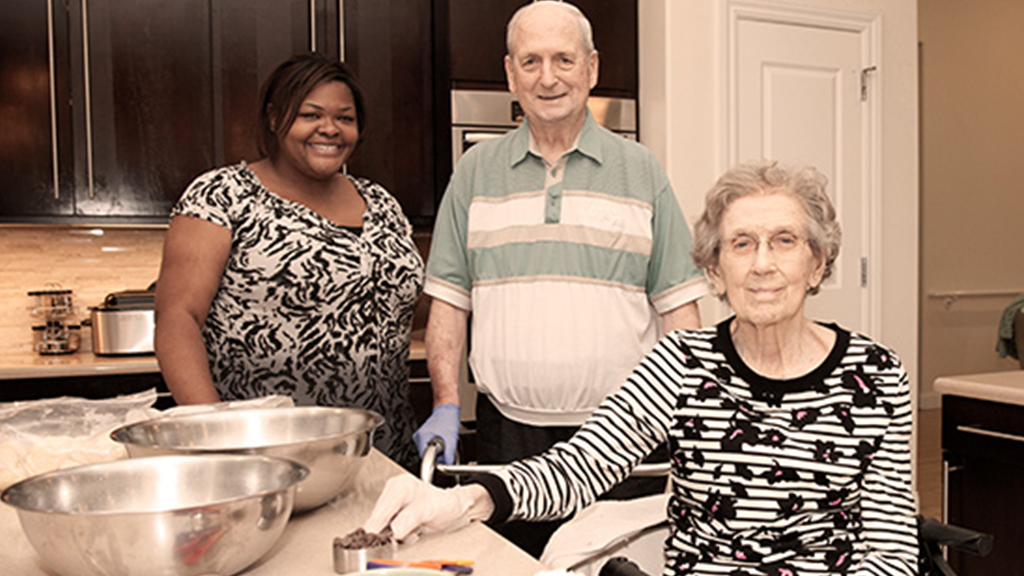What to Look for in Assisted Living and Memory Care Communities

Back to physical health resource hub
Being a caregiver is challenging—physically and emotionally. It takes time and energy to tend to your loved one’s needs and more time and more energy to plan for their future care. There could come a point as a caregiver when you can no longer manage the care yourself. While there are many in-home options for caregivers, this article will focus on things to consider when placing your loved one in an assisted living or memory care community.
Style
Small Home: some assisted living sites are small homes that take fewer than 10 residents. There can be a large variance in staffing and services in these environments. Some homes were designed and constructed as assisted living homes, while others are homes that were converted to assisted living facilities. This style makes up the largest number of communities across the country.
Free Standing Building: these communities can range in size from 30 to more than 100. Sometimes they combine assisted living and memory care by offering a special secured area for residents with dementia. Other buildings can be offered strictly for memory care. While still others offer only assisted living.
Continuing Care Retirement Community: these campuses encompass many different levels of care including independent living, assisted living/memory care and skilled nursing and rehabilitation. Assisted living and memory care are typically offered in a separate space from the independent living and nursing centers.
Services
Assisted Living and Memory Care communities offer some form of the following services.
Dining: Sites should offer three meals per day and snacks – you will want to know what kind of choice residents have in the times they eat and the selection that is offered. You may also want to know if special diets can be accommodated – both medically advised and preference based.
Recreation: Communities typically offer a variety of daily activities. Ask if there is a published schedule, how activities are communicated to residents, and how residents are encouraged to attend. Do the residents ever go off property for outings?
Staffing: There is a lot of variation in the levels of training for staff in assisted living and memory care communities. One thing in common is that there will be staff on site 24/7. Ask about the types of staff that are used: home health aides vs. certified nursing assistants, nurses vs. medtechs, what is the staffing ratio per shift, etc.
Assistance with Activities of Daily Living: Some sites will accommodate a high level of hands-on care with tasks such as bathing, grooming, dressing, toileting, feeding, transferring and navigating the community. Others are not equipped to handle high levels of care. The Age in Place philosophy allows facilities to provide more care as needed to keep residents in the community longer. Ask who provides the daily care and whether it is scheduled, as needed or a combination.
Call/Alert System: How do residents alert staff that help is needed? Are there pull cords, pendants, an intercom system? How quickly can staff respond to alerts? This will vary among communities. Often in memory care settings, these systems are ineffective because residents lack the cognitive ability to use them. Verify how often memory care residents are checked throughout the day.
Housekeeping/Laundry/Maintenance: Ask questions about how often apartments are cleaned, whether laundry is done separately or collectively and how quickly maintenance can respond to problems with appliances, water pressure, etc.
Transportation: This service will vary the most drastically from building to building. Ask what type of vehicles are used, what types of appointments and outings can be accommodated, what extra fees there are for utilizing transportation and what adaptive equipment the vehicles have.
On-site Physicians, Therapy, Home Health and Hospice: Many communities partner with service providers to come on-site to provide clinical assistance. Most often these providers are third party and do not work for the assisted living communities. Ask for a list of those providers and clarify if your loved one can use their own preferred provider if desired.
Costs and Financials
Assisted Living and Memory Care costs will differ according to the style of community and the services and care provided as outlined above. The following is a list of some of the pricing structure you will encounter when researching options. In Florida residents sign a lease agreement that can be terminated by the resident with a 30 day written notice or upon the death of the resident and removal of belongings from the room/apartment.
Basic Service Rate: This rate will be the standard monthly cost for a room or apartment in an assisted living community. It will vary depending on the size of the room/apartment. It will also include some of the services listed above. This rate may or may not include utilities – ask for an itemized list of what is included.
Level of Care or Service Plan: This price will be in addition to the basic service rate and may vary on the individual needs of the resident. This can be presented as a level, tier or point system where certain services are included at different price points. This level is determined by the prospective resident’s physician’s form/evaluation combined with a nursing assessment by the facility’s nurse. Some communities charge an “all inclusive” pricing system that combines the basic service rate and level of care.
Ancillary/Auxiliary Charges: The community should be able to provide a list of any additional costs that could appear on a monthly statement. Examples of these include but are not limited to guest meals, hair salon or spa services, second person fee, pet fee or pet services, transportation costs and extra laundry/housekeeping services.
Community Fee: This one-time fee is usually charged at the time of the move in. It covers administrative and facility costs for the time that the resident is in the community.
Sources of Payment: The majority of assisted living and memory care communities are paid for with private funds—income and assets. Long-term care insurance policies could have an assisted living benefit that will assist with the costs of the program. Some veterans and their spouses may be eligible for VA Aid & Attendance and should work with a Veterans Service Officer (VSO) to determine eligibility and apply for benefits.
If you would like to learn more about our Bartram Lakes Assisted Living community or our GREEN HOUSE Residences, please click here.


